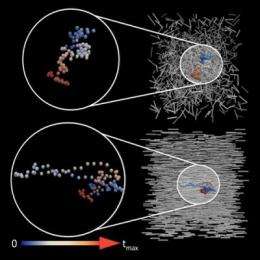Nanorod-assembled order affects diffusion rate and direction

Some of the recent advancements in nanotechnology depend critically on how nanoparticles move and diffuse on a surface or in a fluid under non-ideal to extreme conditions. Georgia Tech has a team of researchers dedicated to advancing this frontier.
Rigoberto Hernandez, a professor in the School of Chemistry and Biochemistry, investigates these relationships by studying three-dimensional particle dynamics simulations on high-performance computers. His new findings, which focus on the movements of a spherical probe amongst static needles, have landed on the cover of February's The Journal of Physical Chemistry B.
Hernandez and his former Ph.D. student, Ashley Tucker, assembled the rodlike scatterers in one of two states during his simulations: disordered (isotropic) and ordered (nematic). When the nanorods were disordered, pointing in various directions, Hernandez found that a particle typically diffused uniformly in all directions. When every rod pointed in the same direction, the particle, on average, diffused more in the same direction as the rods than against the grain of the rods. In this nematic state, the probe's movement mimicked the elongated shape of the scatterers. The surprise was that the particles sometimes diffused faster in the nematic environment than in the disordered environment. That is, the channels left open between the ordered nanorods don't just steer nanoparticles along a direction, they also enable them to speed right through.
As the density of the scatterers is increased, the channels become more and more crowded. The particle diffusing through these increasingly crowded assemblies slows down dramatically in the simulation. Nevertheless, the researchers found that the nematic scatterers continued to accommodate faster diffusion than disordered scatterers.
"These simulations bring us a step closer to creating a nanorod device that allows scientists to control the flow of nanoparticles," said Hernandez. "Blue-sky applications of such devices include the creation of new light patterns, information flow and other microscopic triggers."
For example, if scientists need a probe to diffuse in a specific direction at a particular speed, they could trigger the nanorods to move into a specified direction. When they need to change the particle's direction, scatterers could then be triggered to rearrange into a different direction. Indeed, the trigger could be the absence of sufficient nanoparticles in a given part of the device. The ensuing reordering of the nanorods would then drive a repopulation of nanoparticles that would then be available to perform a desired action, such as to stimulate light flow.
"While this NSF-funded work to better understand the motion of particles within complex arrays at the nanoscale is very fundamental," Hernandez says, "it has significant long-term implications on device fabrication and performance at such scales. It's fun to think about and provides great training for my students."
Provided by Georgia Institute of Technology


















